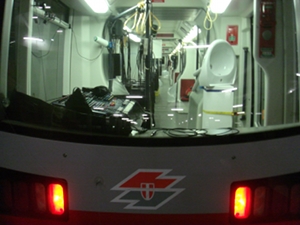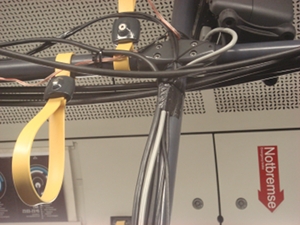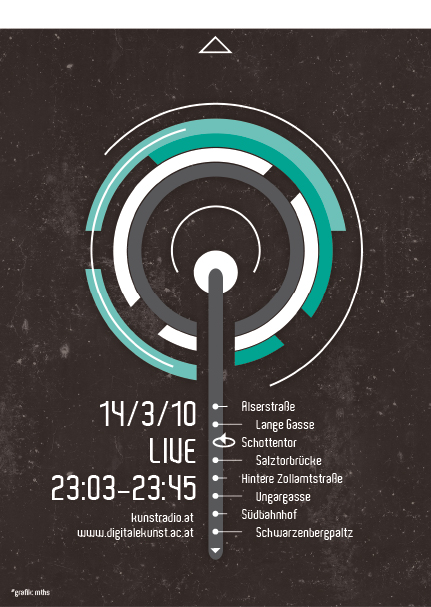„informal radio“ – live aus der Straßenbahn
With works by Kathrin Stumreich,
Viktoria Wöß, JoaKnierzinger, Mara
Bloom, hpl,
Johannes Muik, Daniel Gyolcs, mths,
Miriam Moné, Conny Zenk,
Karl Salzmann, Jan
Perschy, Conny Zenk + mths
A project by Digital Art students
of the University of Applied Arts Vienna,
organised by
Nicolaj Kirisits and Klaus Filip.
Eine Kooperation der Universität für Angewandte Kunst mit dem ORF Kunstradio und folgenden Radiostationen:
FM4 – „Die
graue Lagune
orange94.0 (Vienna)
Radio
Helsinki 92,6 (Graz)
Radio Freirad 105,9
(Innsbruck)
FRS - Freies Radio
Salzkammergut
MiRa Campusradio
94,4 (St. Pölten)
Freies Radio B138 90,4
(Krems)
Radiofabrik 107,5
(Salzburg)
Links:
Digital Arts / University of Applied Arts
Foto report on the fanpage of Vienna’s public transport company Wiener Linien
discussion on the Wiener Linien fanpage
A
COPY OF THIS PROGRAM CAN
BE ORDERED FROM THE "ORF
TONBANDDIENST"
|
ILate at night on 14 March 2010 a
tram transformed into an art space and broadcasting studio at the same
time, was on the road: “informal radio” was a live
on air multi-channel radio performance, including nine radio stations
based throughout Austria. The train was equipped with cables, loud
speakers, mixing desks and computer, and aboard were also inflatable
sculptures, a swing, a tableware cupboard and two sinks. As well as
dozens of artists and passengers.
The tram functioned as a mobile exhibition space for twelve time-based installations by Kathrin Stumreich, Viktoria Wöß, JoaKnierzinger, Mara Bloom, hpl, Johannes Muik, Daniel Gyolcs, mths, Miriam Mone, conny zenk, Karl Salzmann, Jan Perschy, Conny Zenk + mths. Those who hadn’t boarded the train at the tram depot Hernals, the starting point, were able to hop on at six tram stops on the route, which marked the episodes of the ride. Or to listen on the radio. Six microphones were moved through the carriage and provide the sounds for the 6-channel-radio broadcast. Listeners were asked to set up three radios, ideally stereo, and tune each in to another station:
 „The tram becomes an exhibition space. Its movement relates to twelve time based works installed inside. The stations on the route allow people to get on the tram, and they structure the ride in temporal sequences. The performative exhibition is displayed through sic acoustiv perspectives, broadcast live on the radio. By moving the six microphones through the exhibition space, the sounds within the tram become the material for a time based deconstruction of space in a multi-channel radio installation. A multi-perspective listening situation unfolds in the private listening space, as the radio audience ist requested to set up three radio receivers and tune them in to three radio stations.” The plan was to leave the train depot at 23pm sharp. However, due to a capacity overload of the they electricity supply through the installations the train started some 20 minutes late. At the first stop, Alser Straße, people got on the train which transformed the tram into a crowded art space. In the meantime, the radio broadcast of „informal radio“ had started: six people with pin-up microphones walked through the train carriage, slowly and one after another. Starting at the rear, they walked up to the front where they got off and ran back to the end of the train. The first two micophones fed the channels of Ö1, the middle ones those of FM4, and the last ones provided the sounds for the free radio programmes such as orange94.0. The ORF technicians aboard were Martin Leitner, Susanne Wirtitsch and Hannes Stern, who explained the technical background of the live radio show: “We broadcast the single channels via three stereo transmitters to the Kahlenberg, where the ORF has three stereo receivers. Via El-net, a digital line, the data are transported to the Funkhaus in Vienna and then disseminated on the three radio stations. For each we have one antenna attached to the outside of the tram, cable-connected with the up to 16 Watt transmitters. For the stereo transmission you have to add and subtract the two channels in order to generate a Multiplex frequency. This modulation is sent to the receivers and via subtraction and addition this mix of frequencies can be transformed back into two channels. It is quite recent that the equipment was developed.“  Kathrin Stumreich // DER FADEN // http://www.kathrinstumreich.com Viktoria Wöß // schaukel joaknierzinger // toilettophone // http://joak.nospace.at/ Mara Bloom // monolog einer straßenbahnreisenden HPL // elektrostimmen Johannes Muik // mängel gegenstände hängen // http://www.muiki.mur.at Daniel Gyolcs // Radio#maT mths // radio feedback // http://mtks.tumblr.com Miriam Moné // schienenlieder Conny Zenk // ▀▀ ▀▓▓▀╘════ Conny Zenk + mths // aufblasbar // http://gaffabandl.wordpress.com Karl Salzmann // Transport³ // http://www.karlsalzmann.com Jan Perschy // hot bin // http://janperschy.com |

PROGRAM
CALENDAR
CALENDAR
